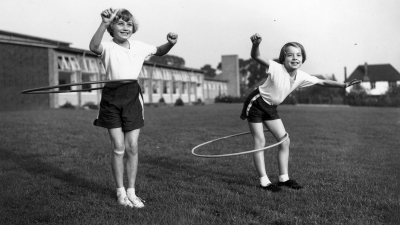
The hula hoop craze of the late 50’s can be traced to Australia, where children twirled hoops made out of bamboo. When the production of bamboo hoops could not meet the demand, Toltoys was engaged to make hoops out of plastic and sold 400,000 hoops in 1957.
Hula Hoops from the 50’s were small colorful plastic tubes made primarily for children to play and exercise. Today, hula hooping has come full circle. Children still love them and adults have begun using stronger, larger, heavier hoops for fitness and fun.
Hoops were popular in Great Britain in the 14th century as a form of recreation and religious ceremonies. Medical records from the era record doctors treating dislocated backs and heart attacks that were attributed to hooping.
The term “hula hoop” came from British sailors who had seen hula dancing in the Hawaiian Islands and thought it looked similar to the movements of hooping back home. Hooping was again popular in England in the 1800 where children would roll hoops with a stick or spin the hoop around their waist.
Hoop dancing is a form of storytelling for Native American Indians dating back to the 1400s. With no beginning or end, it symbolizes the never-ending circle of life. Dancers used dozens of small hoops, typically made of reeds, as symbolic representations of animals such as eagles, snakes, butterflies or coyotes. Their hoop dance uses very rapid movements and the off-body use of hoops to construct symbolic forms around their bodies. Tony White Cloud ushered in modern Native American hoop dancing in the 1930s when he began using multiple hoops to perform stylized dances to weave stories of how life is connected with changes and transitions.
There is an annual Native American Hoop Dance competition at the Heard Museum in Phoenix, Arizona.
Credit : Hula Hooping
Picture Credit : Google




